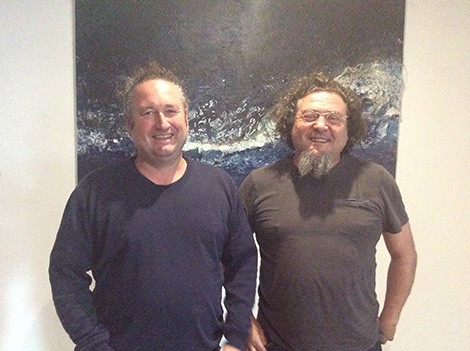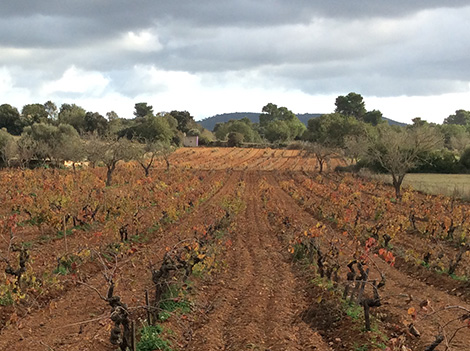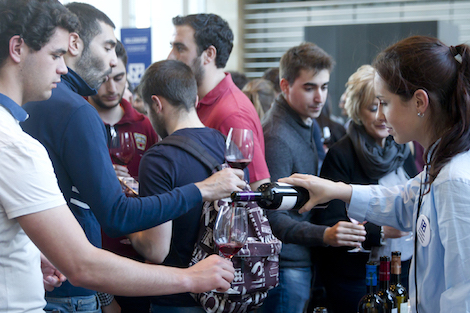
After our visit to the largest island in the Balearics to gauge the current state of its wine industry and to find out more about its grape heritage, we have reviewed the producers we met plus others who are driving the wine scene in Mallorca.
Ánima Negra (Felanitx, VT Mallorca)
Pioneers of high quality wines made from Callet grown in Felanitx, Ánima Negra was the brainchild of Pere Obrador who set up the business in his family home together with his brother-in-law Miquel Angel Cerdà.
It’s worth visiting some of their 30 hectares of old vines. Owned by local growers, they have preserved traditional growing methods in their plots such as planting patterns and mixing vines and fruit trees. Some vineyards have survived thanks to the stubbornness of their owners who rejected juicy real estate offers. Ánima Negra owns 25 hectares planted mostly to Callet but there are also two hectares of Giró Ros, the variety with pinkish-coloured berries that is behind some of the most interesting white wines in Mallorca.
Grapes for the entry level red An/2 are sourced from the youngest Callet vines and includes Manto Negro from Binissalem and some international varieties. In contrast, Án Negra (the first Mallorca wine to earn a spot among Spain’s top reds) only sources grapes from Felanitx. Callet is a key ingredient at Ánima Negra to the point that it represents 50% of the blend of their intriguing white Quíbia, a wine that has been gaining definition over the years. The top red Son Negre, which is only produced in exceptional vintages, bears a new label in every new vintage, all of them designed by local artist Miquel Barceló.
4 Kilos Vinícola (Felanitx, VT Mallorca)
Francesc Grimalt, former winemaker at Ánima Negra, and Sergi Caballero, a founding member and art director of Sónar music festival, launched their project in Felanitx with 4m pesetas (€24,000), hence the name. Their fragrant, delicate wines are great ambassadors of the new Mediterranean style in tune with the international trend towards less structured, more expressive reds. The wide availability of the wines -only 30% of their production is sold in the Balearics- has notably helped 4 Kilos to gain a prominent position among local producers.
Respecting biodiversity and managing their vineyards as if they were forests are two basic pillars of their philosophy. For Grimalt, carbonic maceration is the most distinctive type of Mediterranean fermentation, so expect to find a certain amount of whole bunches in most of the 4 Kilos reds.
It was interesting to taste different barrel samples of Callet, each with its own profile, ranging from featherweight to particularly deep and juicy examples. This is the fascinating puzzle behind 4 Kilos, their flagship red, whose grapes are sourced from reddish soils in Felanitx locally known as call vermell. The entry-level red 12 Volts is made from grapes grown in different areas of the island on clay-dominant soils. The blend includes some international grape varieties which are often co-fermented. Wine geeks will surely enjoy Motor América, the winery’s experimental, sulphur-free, low alcohol (11% vol. in the 2016 vintage) red which is partially made in terracotta vats and fits the vin the soif category.
Sistema Vinari. Grimalt and Caballero went further with the creation of an independent company in partnership with Eloi Cedo, cellar master at 4 Kilos, to craft natural wines exhibiting fun, sometimes irreverent labels. The 2016 Cható Pqta (it used to be Château Paquita but the name changed due to legal and trademark registration issues) includes some whole-cluster fermented Monastrell together with Callet and Manto Negro. The style is fresh with wild herb notes (another vin de soif). Its limited production has helped to make it a sort of cult wine among aficionados.
Gallinas & Focas. 4 Kilos also works with Amadip Esment, a charity for the mentally handicapped. Their members actively take part in the harvest and the making of two wines featuring dynamic, casual wine labels. Gallinas & Focas is a blend of Manto Negro with a bit of Syrah whereas Tanuki Bob is a 100% Manto Negro which is partly fermented with stems to get some carbonic maceration and results in a fresh, easy-drinking red.
Miquel Gelabert (Manacor, Pla i Llevant)
Given that he makes 22 different wines (60,000 bottles) from up to 30 grape varieties, it’s not strange that Miquel Gelabert is affectionately known as “the mad man of Manacor”. He started with a small plot owned by his father-in-law and now controls 10Ha located mostly in Manacor but also on Petra and Felanitx nearby. “Tourism has brought wealth, but it has also eaten away our vineyards,” he laments from his cramped winery in an alleyway in Manacor.
Gelabert tends his vines organically but has no certification to prove it because he refuses to be part of a group that at times “doesn’t do what it says it does.” Except from the sweet wines, his range bears the DO Pla I Llevant seal. On my visit I focused on wines made from indigenous grapes like Autòcton, a blend of Callet, Manto Negro, Fogoneu and Gargollassa that shows Mallorca’s distinctive character and combines fragrance and earthy notes evoking Mediterranean forests. Callet is the dominant variety in Gran Vinya Son Caules 2011 (it includes other varieties found in old vines), one of the most singular wines from this variety that I tasted during my visit to the island. It had benefited from some bottle aging but still had freshness and tension. In terms of whites, Sa Vall (70% Giro combined with Viognier and some Roussanne) was my favourite. I tasted a promising 2013 in Manacor and a few days later in Madrid, I had the chance to taste a 2012 showing great depth and complexity thanks to the extra time in bottle.
Toni Gelabert (Manacor, Pla i Llevant)
The other Gelabert in Manacor set up his wine business in 1979. He now grows 5Ha of vines and produces 14 different wines and 30,000 bottles. All his vineyards are organically certified and he also practices biodynamics; in fact, Toni Gelabert pioneered biodynamic wine growing in Mallorca.
One of his great contributions to the island’s wine scene has been the recovery of Giró Ros, the indigenous white variety, from half a dozen plants that survived in a very old vineyard on the limits of Felanitx. Torre des Canonge, his 100% Giró Ros is a must for anyone willing to explore the wines of the Balearic Islands. Gelabert says this great white variety is capable of producing structured, long-lived wines with the ability to age. Growing 1.5Ha of Giró Ros is somewhat complicated as the plant suffers from millerandage and is very sensitive to humidity which results in low yields. Gelabert has been very critic of the fact that it took almost 12 years to officially authorize Giró Ros while international grapes like Pinot Noir were easily accepted by the local authorities.
Nevertheless and like many producers in Mallorca, he works both with local and international grapes. Other relevant indigenous varieties in his vineyards include Prensal Blanc and Callet, which has adapted well to his area and is the main ingredient in his energetic red wine Illenc. I couldn’t visit the winery but Gelabert kindly sent me samples to taste.
Bàrbara Mesquida (Porreres, VT Mallorca)
After overcoming some family disputes and leaving behind the winery created by his great-grandfather in 1945 in Porreres (and later managed by his father using international varieties), Bàrbara started on her own from scratch. She is totally committed to biodynamics and in fact holds one of the first Demeter certifications in Spain. She grows 20Ha, 60% of which are planted with international grapes. One of her most beautiful vineyards is Son Porquer, set up around an old mill standing among the vines.
She produces 90,000 bottles, 75% of which are sold in the islands; the rest travel abroad with some batches making their way to a handful of cities in the mainland. I tasted a vat sample of Acrollam 2017 (Acrollam is Mallorca written backwards), a pleasant blend of Prensal (60%) and Giró Ros (40%) with a good balance between the sweet fruit and its mineral finish. With evocative labels designed by Xavier Bass, Bàrbara’s more personal wines are Trispoll (floor in the Majorcan language; the floor tiles at her grandparents’ home appear on the label), a blend of Syrah and Cabernet softened by 20% Callet with autumnal notes (forest, firewood) and the bold structure expected from international grapes. A blend of 90% Callet and 10% Manto Negro, Sòtil (sky) is the opposite: an aerial, delicate and juicy red with just 12.5% vol. in the recently released 2016 vintage.
Ribas (Consell, VT Mallorca)
Mallorca’s notable historic producer owns some of the oldest vineyards in Mallorca and has preserved the family’s manor house in Consell with the year 1776 carved on the stone facade. They were one of the founders of the DO Binissalem, but they left the appellation a decade ago when quantity became more important than quality. “We also wanted to introduce international varieties and grow others; we never planned to dispose of our vine heritage but we wanted to age our wines,” says Araceli Servera who is currently at the helm.
The family owns 43 hectares which translate into 150,000 bottles per year. Most of them are located in Can Ribas, a strip of mostly unirrigated land next to the manor house. Soils are loamy-sandy with gravel and rolling stones which explain the wines’ finesse. According to Araceli, Manto Negro is an oxidative variety that naturally produces high alcohol wines. She finds that fermenting in concrete tanks helps to keep temperature under control. When it comes to aging, they are gradually incorporating 500l oak barrels.
Manto Negro is the base in the Ribas reds with varying percentages ranging from 60% to 100%. It is usually blended with Syrah although the family has decided to preserve two plots planted to Cabernet Sauvignon and Merlot. They recovered Gargollassa, a grape on the verge of extinction, and are using it to reduce alcohol levels and as an ingredient in the delicious and fun Ribas rosé which mostly comes from Manto Negro young vines. I also tasted Sió, a red with 60% Manto Negro and the single-varietal Desconfía De La Gente Que No Bebe Vino, featuring a rather provocative label. The name can be translated as “Distrust people who don’t drink wine”. Both deliver a striking texture and fine tannins without a trace of rusticity.
Tianna Negre (Binissalem, DO Binissalem and VT Mallorca)
Director Xisca Morey exhibits an impressive pedigree. While her paternal family (Antonio Nadal) is a key player in the island’s liqueur and distribution industry, her mother’s side boasts a long-standing winegrowing tradition in Consell –Xisca even recalls seeing more Callet than Manto Negro in their vineyards.
Launched in 2000, Tianna Negre started with the planting of several vineyards. The first vintage of Ses Nines, a popular brand in the island’s restaurants, was 2004 but the current state-of-the-art facilities were inaugurated with the 2007 vintage.
Tianna Negre includes many brands. Different ranges are produced for the hospitality industry and tailored-made wines are commissioned in other regions like Rueda or Ribera to feed their powerful distribution business. The Ous & Cargols line for instance (“eggs and snails” roughly means comparing apples with oranges) blends red and white grapes. One of my favourite wines was Veló 2016, a 100% Manto Negro with a lovely Mediterranean expression over an earthy background without a trace of rusticity. It is sold as DO Binissalem but the restriction on the use of grapes in this appellation has led Tianna Negre to release an increasing number of wines as VT Mallorca.
Of particular interest is their work with minor grape varieties. In partnership with the regional government’s Agriculture department, Tianna Negre are growing 11 indigenous varieties including Callet Can Concos which happens to be the mother of Callet and Manto Negro. They are also experimenting with different fermentation and aging vessels such as stainless steel, concrete or wooden vats. The high-end range includes Tianna Negre 2015, a firm, fine and spiced blend of local and international grapes sold at around €30. One step up is the “Sommelier Collection” which includes two single-varietal wines made from Callet and Manto Negro respectively. Finally, “Boutique Wines TN5” is a limited series that has resulted so far in a single-varietal Syrah (Number 1), an orange wine made from Giró Ros (Number 2) and a dry Muscat-à-Petit-Grains (Number 3).
Binigrau (Biniali, VT Mallorca)
At the beginning of the 2000s the three Batle siblings, former owners of Macià Batle, started this venture which currently produces 180,000 bottles a year. Their first vintage, 2002, was released as DO Binissalem but as Chardonnay is restricted in this appellation, wines are now sold as VT Mallorca, mostly in the local market (60% of production); the rest goes overseas with no sales in mainland Spain.
Interesting blends of local and foreign varieties are produced at their modern, smart bodega at the entrance of Biniali. The wines might not be terribly terroir-driven but they are balanced and consistent with a style that is set to please a broad spectrum of consumers. The entry-level range includes two organic wines, a red and a rosé under the Binigrau-e brand. More representative are the white Nounat, a blend of Prensal (60%) and Chardonnay (40%) boasting exotic fruit (peach, mango) and more volume in the palate than you’d expect from a wine retailing at €12; and the juicy, spicy Obac (around €14), a good example of Mallorca’s most widely grown red grapes. It is a field blend of Manto Negro and Callet mixed with 50% Syrah, Cabernet and Merlot. Their top “B” Selección range includes a jammy, structured red with 80% indigenous grapes and a 100% Chardonnay.
Vins Tramuntana (Pollença, VT Mallorca)
Owned by José Antonio González, a member of the managing team at Spanish tourist operator Iberostar, Vins Tramuntana originates in a property saddled between Alcudia and Pollença in northern Mallorca. Grape varieties include Merlot, Syrah, Manto Negro and Gorgollassa. According to González, Gargollassa was already mentioned by the archduke Luis Salvador of Austria who spent long periods of time in the island and also produced wine in this area.
A wet region due to the proximity of the sea, it also benefits from the sea’s breeze. Raúl Pérez, the well-known winemaker from Bierzo, helped out on the first two vintages, 2011 and 2012, but he passed on the baton to Dominique Roujou, a Frenchman living in Galicia.
Tramuntana’s portfolio includes four red wines with a total production of 15,000 bottles. The entry-level Xanet (€15) is made from Merlot plus some batches previously discarded from other wines and some bought-in Callet. Syrah-based Cadmo includes a small amount of indigenous grapes and the high-end range includes two single-varietal reds made from Manto Negro (Cumas) and Gargollassa (Sibilia). With its fresh, sapid edge, Sibilia was my favourite. Apart from Cadmo, the wines may fail short in the mid-palate but are well-balanced, have bright acidity and develop nicely in bottle.
Son Mayol (Palma, VT Mallorca)
One of the most ambitious projects in Mallorca in recent times, Son Mayol is based in an area with no winegrowing tradition (Establiments is just a few kilometres north of Palma). Wines follow a Bordelais style as Patrick Léon, former director at Château Mouton-Rothschild, is the star wine consultant while Marie Barbé, an experienced French winemaker with a solid background in distant wine regions like Russia and India, manages the day-to-day business.
The winery and the vineyards are part of a 250Ha property owned by a Swiss entrepreneur who wishes to remain away from the limelight. The first vines were planted in 2008 along with other crops like olive trees and a livestock farm rearing Angus veal. Only 7,000 bottles were produced on 2014, their first vintage, but there are plans underway to farm 60Ha and produce 300,000 bottles. The estate has nothing to envy from the famous châteaux in Bordeaux. Top materials and technology, including optical selection tables, are in place and the stunning winery building, designed by Valencian architect Javier Campos, is available to host events and celebrations.
Two wines are produced under the Son Mayol brand. Meant to be consumed on release, the Premier Vin blends 75% Merlot and 25% Cabernet Sauvignon. In contrast, the Grand Vin (€70) is a classic Bordeaux blend with 70% Cabernet and is meant to be cellared.
Son Vives (Banyalbufar)
I couldn’t visit this winery owned by Toni Darder nor taste its Malvasía wines. Production is so tiny that there were no samples available from previous vintages and the 2017 were not yet ready. It is interesting, however, that Son Vives is producing dry Malvasía which I am looking forward to taste soon.
Although of little importance in terms of quantity, the recovery of Malvasía de Banyalbufar (officially renamed as Malvasía Aromática, it is the same as Malvasía de Sitges) is great news for Mallorca. The old terraces overlooking the sea in a breathtaking area of Serra de Tramuntana have been recovered and the grape’s naturally high acidity is a great tool against climate change. This new stage comes after years of hard work and failed attempts to find healthy plants to reproduce —most of them were affected by serious diseases like fanleaf virus or leafroll. Success was finally achieved thanks to the work carried out by the Department of Plant Physiology at the UIB (Balearic Islands University) led by Professor Hipólito Medrano. Son Vives currently grows 1.75Ha of Malvasía, a Mediterranean jewel that has happily been brought back to life.

Amaya Cervera
A wine journalist with almost 30 years' experience, she is the founder of the award-winning Spanish Wine Lover website. In 2023, she won the National Gastronomy Award for Gastronomic Communication
Wine tastings in March 2018
NEWSLETTER
Join our community of Spanish wine lovers






